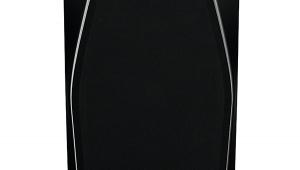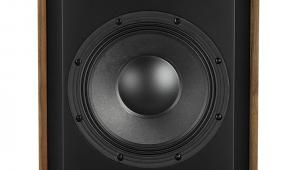Q Acoustics 5050

 The Largest Of Q Acoustics' 5000 Series Speakers Combines Inspiration From The Concept 50 With Ideas Of Its Own
The Largest Of Q Acoustics' 5000 Series Speakers Combines Inspiration From The Concept 50 With Ideas Of Its Own
Armour Home's Q Acoustics has been busy in recent years, refreshing nearly its entire portfolio of passive and active loudspeakers, and expanding existing lines. The Concept 50 and 30 models were launched in 2022 to fill out its top-flight range, which includes the Karl-Heinz Fink-designed Concept 500 flagship , and a more affordable 5000 series appeared just before High End Munich in 2023. This didn't arrive fully complete either - the largest 5050 floorstander we're looking at here only finally debuted in the Spring of 2024.
Featuring a familiar two-way MTM design but using a bigger cabinet and larger C3 bass/mid drivers than the smaller 5040 floorstander, Q Acoustics' new £1299 loudspeaker finishes off its mid-level series, sitting above the entry-level 3000 models. Various technologies are trickled down from the Concept range, including the use of proprietary cabinet bracing and internal Helmholtz Pressure Equalisers, while the styling is also said to 'lean towards the elegant form' of the most recent Concepts.
Pet Sounds
It certainly looks similar, with slim dimensions accentuated by curves to the top and bottom cabinet edges - a choice that also has acoustic advantages, such as limiting internal standing waves. There are four smart colour choices on offer - black or white (both in a satin finish), with oak and rosewood as wood veneer options. Q Acoustics typically manages to provide a lovely fit and finish for the price demanded, and its latest loudspeakers have further upped the game. The build of the 5050's cabinet appears seamless, with a pleasing assimilation of the black-toned acrylic baffle into the fascia.
Tall plus slender could equal unstable, so those with hyperactive children or inquisitive pets will be reassured to discover a supplied two-part metal stabiliser, which attaches to the bottom of the speaker below its single set of low-profile binding posts. Spikes are also included in the box, as are rubber end-caps - a blessing if you have parquet floors. Two of these spikes are for fitting directly underneath the front of the 5050's cabinet, the other pair fit on the outriggers. It's an effective solution that doesn't detract from the overall sleek form.
Point-To-Point
As befits a manufacturer that likes to keep a design and refine it with each iteration, there's a lot present in the 5050 that's familiar, going all the way back to the Concept 500. As mentioned, there are two Helmholtz Pressure Equalisers inside to attenuate dimensional modes within the cabinet, and the 5050 is internally braced at strategic positions. However, Q Acoustics has elected to use slimmer point-to-point bracing here, while the 'gelcore' multilayer construction of its Concept models isn't present, the 5050 being instead constructed from solid MDF.
Between the speaker's two 150mm bass/mid drivers is a 25mm dome tweeter, with vented rear chamber, that's hermetically sealed to prevent interaction with the output of the larger units. This high-frequency driver is not identical to the most recent Concept design but, again, there's trickle-down at work, including mechanical isolation from the front baffle. Notably, the crossover point is at 2.7kHz, higher than the 2.1kHz of the Concept 50.
While the 5050's modest size allows for use in a compact living room, it is ported at the back so some care should be taken regards placement close to a rear wall. Q Acoustics suggests a relatively tight 20cm clearance is acceptable (and supplies foam bungs to short the ports if you need to go closer still), plus 50cm from side walls and the cabinets sat 2m-4m apart and equidistant from the listening position. Toe-in is also recommended, with the addendum that 'loudspeaker positioning in a room is not an exact science'.
Tour De Force
Connecting the 5050s to a Lyngdorf TDAI-3400 integrated amplifier , and conveniently siting them either side of an OLED TV, all is set for some serious music listening. But Q Acoustics is a brand with an eye on TV sound too, and these speakers' tuning makes them suited to that use. Case in point, the first hour or so of The Eras Tour Of Taylor Swift [Disney+; 48kHz 24-bit] delivered electrifying stadium-scale ambience and excellent vocals, while turning up the volume enabled some full-bodied bass, impressing with its size if not with fine detail.
The 5050 doesn't over-emphasise the presence region, giving it a somewhat reserved-sounding profile. Hearing it shortly after Bowers & Wilkins' 702 S3 Signature towers made it appear at first a darker, more distant performer. This relative neutrality has its merits, though, particularly when consuming music over a longer period of time. What the 5050 delivered was fatigue-free listening, and with a more gradual roll-off when you move out of the sweet spot. This is handy for anyone not seated at the point of the stereo triangle, and other listeners will appreciate the speaker's room-filling capability.
Earn Your Stripes
Its coherency and crisp midrange are great for explosive rock music, as I discovered when streaming The White Stripes' White Blood Cells [XLCD 151; 44.1kHz/24-bit]. Jack White's guitar was satisfyingly grungy and fat, brought to the front compared to his vocals, while the sound of Meg White beating the drums to death was full of energy. High-fidelity this recording might not be, but the speaker easily communicated the fun and exuberance of songs like 'Fell In Love With A Girl' and the stop-start 'I Think I Smell A Rat'.
There's a lot of texture in the strings during the intro of 'Illusion', a highlight of Roger Eno's The Skies, They Shift Like Chords... album [Deutsche Grammophon; 96kHz/24-bit]. The languid pacing let me savour the careful arrangement of the cellos of the Scoring Berlin ensemble, counterpointed by a nimble and bright piano melody reminiscent of something Yann Tiersen would play. This track and others on the album are classed as 'ambient', which is certainly how the 5050s served them up. Their slightly reserved but also expansive portrayal fitted Eno's work perfectly, just like it would - say - some cool Scandinavian jazz, and I did find that removing the grilles added a touch more high-frequency detail.
Killer Riffs
Swapping out the Lyngdorf amp for Primare's compact, interior-friendly SC15 Prisma MK2 DAC/streamer and I15 analogue amplifier introduced a little more warmth to the proceedings, making Talking Heads' classic 'Psycho Killer' [Talking Heads: 77; Warner Bros 96kHz/24-bit Download] More Satisfying, With Increased Punch And Attack To The Drum Kit And Jerky Guitar Riffs.
Listening to this polished track it is hard to believe it was part of a debut record and only the first outing for David Byrne's unmistakable voice. Then again, playing the album through the 5050s it was easy to hear the many influences of the '60s and early '70s trickling through. Indeed, while the emphasis with these speakers is on delivering a controlled 'wall of sound' experience, they're not lacking in clarity, especially when it comes to the midrange.
Exciting Times
There was also a foot-tapping quality to the presentation of this quirky set, with the steel drums on 'Uh-Oh, Love Comes To Town' and the marching drums on 'Tentative Decisions' setting the pace perfectly. The 5050s also rendered 'Dog Days Are Over' from Florence + The Machine's Lungs [Universal 00602527112398] in an exciting manner - dense and powerful, but with the lightly strummed mandolin floating out of the mix from time to time.
Q Acoustics' keenly priced floorstanders give you a recognisably 'audiophile' sense of detail without losing sight of the importance of excitement and engagement. Perfectly suited, then, to the active listener looking for both immersive listening and a quick adrenaline rush before heading out to the pub...
Hi-Fi News Verdict
Q Acoustics' impressive 5050 takes a tried-and-trusted design, refines it further and ices the cake with a tempting price point. The slender design will make it welcome in living rooms where traditional hi-fi speakers are banned, without compromising on sound quality. No surprise there, as behind the sleek lines and smart colourways there's solid R&D and an emphasis on delivering a 'quiet' cabinet.
Sound Quality: 86%























































